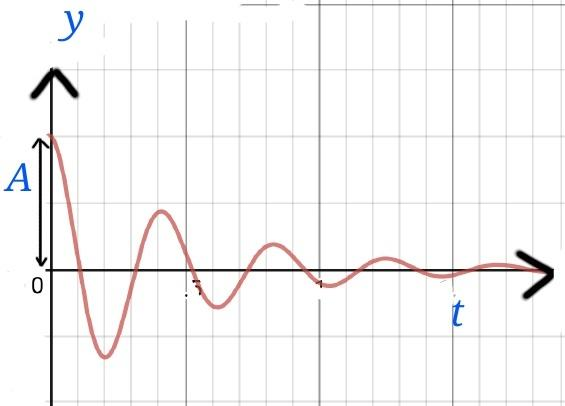
Define oscillatory motion.
Answer
588.6k+ views
Hint: A motion is said to be oscillatory if its diagram in displacement-time graph is either
A. Sinusoidal with constant amplitude. (undamped)
B. Sinusoidal with decreasing amplitude. (damped)
Complete step-by-step answer:
We first need to know about the simple harmonic motion where the force on a body is proportional to its displacement from a mean position. Its equation of motion can be given by,
$$m\dfrac{d^2y}{dt^2}+R\dfrac{dy}{dt}+ky=0$$
Where R is the damping force per unit velocity of the object. k is called the force constant. The equation is modified as,
$$\dfrac{d^2y}{dt^2}+2b\dfrac{dy}{dt}+\omega_0^2y=0$$
Here, $$2b=\dfrac{R}{m}$$ and $$\omega_0^2=\dfrac{k}{m}$$
Undamped oscillatory motion- In this case, R=0 $$\Rightarrow$$ b=0. Hence the equation reduces to,
$$\dfrac{d^2y}{dt^2}+\omega_0^2y=0$$
The solution will be, $$y=A.cos(\omega_0t-\theta) $$
Where, A is the amplitude of oscillation and $$\theta$$ depends on the initial conditions. Its diagram looks like…..

Its energy is given by,
$$E=E_k+E_p=\dfrac{1}{2}m(\dfrac{dy}{dt})^2+\dfrac{1}{2}m\omega_0^2y^2\\=\dfrac{1}{2}m\omega_0^2A^2 $$
Damped oscillation- In case $$b\neq 0$$, oscillation can only be observed if $$b\leq \omega_0$$ and in all the other cases no oscillation will be observed.
If $$b\geq \omega_0$$ ,the motion is called over damped.
If $$b=\omega_0$$, the motion is said to be critically damped.
In these two cases there is no oscillation. For oscillation (damped), $$b\leq \omega_0$$
In this case, the solution is given by, $$y=A.e^{-bt}.cos(\omega t-\theta)$$
Here, $$\omega=\sqrt{\omega_0^2-b^2}$$

The diagram will look like this.
In this case, the amplitude decreases as , $$A_1=Ae^{-bt}$$
Its energy can be shown to be $$E=\dfrac{1}{2}m\omega_0^2A^2e^{-2bt}$$
Note: There is another type of oscillation that is called forced oscillation. In this case, the system is forced to move in oscillation by an oscillatory external force.
A. Sinusoidal with constant amplitude. (undamped)
B. Sinusoidal with decreasing amplitude. (damped)
Complete step-by-step answer:
We first need to know about the simple harmonic motion where the force on a body is proportional to its displacement from a mean position. Its equation of motion can be given by,
$$m\dfrac{d^2y}{dt^2}+R\dfrac{dy}{dt}+ky=0$$
Where R is the damping force per unit velocity of the object. k is called the force constant. The equation is modified as,
$$\dfrac{d^2y}{dt^2}+2b\dfrac{dy}{dt}+\omega_0^2y=0$$
Here, $$2b=\dfrac{R}{m}$$ and $$\omega_0^2=\dfrac{k}{m}$$
Undamped oscillatory motion- In this case, R=0 $$\Rightarrow$$ b=0. Hence the equation reduces to,
$$\dfrac{d^2y}{dt^2}+\omega_0^2y=0$$
The solution will be, $$y=A.cos(\omega_0t-\theta) $$
Where, A is the amplitude of oscillation and $$\theta$$ depends on the initial conditions. Its diagram looks like…..

Its energy is given by,
$$E=E_k+E_p=\dfrac{1}{2}m(\dfrac{dy}{dt})^2+\dfrac{1}{2}m\omega_0^2y^2\\=\dfrac{1}{2}m\omega_0^2A^2 $$
Damped oscillation- In case $$b\neq 0$$, oscillation can only be observed if $$b\leq \omega_0$$ and in all the other cases no oscillation will be observed.
If $$b\geq \omega_0$$ ,the motion is called over damped.
If $$b=\omega_0$$, the motion is said to be critically damped.
In these two cases there is no oscillation. For oscillation (damped), $$b\leq \omega_0$$
In this case, the solution is given by, $$y=A.e^{-bt}.cos(\omega t-\theta)$$
Here, $$\omega=\sqrt{\omega_0^2-b^2}$$

The diagram will look like this.
In this case, the amplitude decreases as , $$A_1=Ae^{-bt}$$
Its energy can be shown to be $$E=\dfrac{1}{2}m\omega_0^2A^2e^{-2bt}$$
Note: There is another type of oscillation that is called forced oscillation. In this case, the system is forced to move in oscillation by an oscillatory external force.
Recently Updated Pages
Why are manures considered better than fertilizers class 11 biology CBSE

Find the coordinates of the midpoint of the line segment class 11 maths CBSE

Distinguish between static friction limiting friction class 11 physics CBSE

The Chairman of the constituent Assembly was A Jawaharlal class 11 social science CBSE

The first National Commission on Labour NCL submitted class 11 social science CBSE

Number of all subshell of n + l 7 is A 4 B 5 C 6 D class 11 chemistry CBSE

Trending doubts
What is meant by exothermic and endothermic reactions class 11 chemistry CBSE

10 examples of friction in our daily life

One Metric ton is equal to kg A 10000 B 1000 C 100 class 11 physics CBSE

1 Quintal is equal to a 110 kg b 10 kg c 100kg d 1000 class 11 physics CBSE

Difference Between Prokaryotic Cells and Eukaryotic Cells

What are Quantum numbers Explain the quantum number class 11 chemistry CBSE




